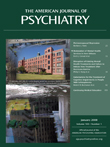Ethnic Density of Neighborhoods and Incidence of Psychotic Disorders Among Immigrants
Abstract
Objective: A high incidence of psychotic disorders has been reported in immigrant ethnic groups in Western Europe. Some studies suggest that ethnic density may influence the incidence of schizophrenia. The authors investigated whether this increased incidence among immigrants depends on the ethnic density of the neighborhoods in which they live. Method: This was a prospective first-contact incidence study of psychotic disorders in The Hague, by ethnicity and neighborhood of residence. Over a 7-year period, individuals who made contact with a physician for a suspected psychotic disorder underwent diagnostic interviews and received DSM-IV diagnoses. A comprehensive municipal registration system provided the denominator for incidence rates. Data were sufficient to examine incidence rates in native Dutch and in first- and second-generation immigrants from Morocco, Suriname, and Turkey. The ethnic density of a neighborhood was computed for each immigrant group as the proportion of residents belonging to that group. Multilevel regression analyses predicted the incidence of psychotic disorders as a function of individual ethnicity and neighborhood ethnic density. Models were fitted for all immigrants together and for each immigrant group separately. Results: A total of 226 native Dutch and 240 immigrants were diagnosed as having a psychotic disorder. Compared with native Dutch, the adjusted incidence rate ratio for immigrants was significantly increased in low-ethnic-density neighborhoods (2.36) but not in high-ethnic-density neighborhoods (1.25). There was a strong interaction between individual ethnicity and neighborhood ethnic density as predictors of incidence of illness. These findings were consistent across all immigrant groups. Conclusions: The incidence of psychotic disorders was elevated most significantly among immigrants living in neighborhoods where their own ethnic group comprised a small proportion of the population.



